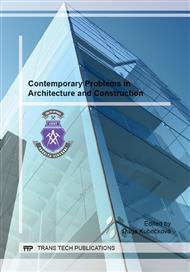p.769
p.776
p.783
p.789
p.796
p.803
p.807
p.811
p.817
The Assessment of Construction Project Management Maturity Level in the Silesian Region in Poland
Abstract:
Every construction investment is a project requiring close coordination, the freedom of access to the information, the application of special activity techniques and most of all the high level of maturity of construction project management. Findings of research conducted in different areas of project management confirm that the assurance of high level of project management maturity conditions the achievement of project's success. The higher level of maturity means the greater degree of capability to manage a construction project. The aim of the article is verification of the following hypotheses: H1: Polish construction companies in a small extent use integrated management of construction project. H2: The highest maturity of construction project management appears in knowledge areas connected with cost management and time management H3: The lowest maturity of construction project management appears in the areas of knowledge connected with risk management and communication management. The study reported in this article was conducted during 2013 year in the construction sector. The survey method was applied in research process. The research embraced 23 construction companies. The respondents are managers of the highest and medium level of management in construction companies. The respondents indicated one out of five maturity levels for selected nine knowledge areas: Level 1: „Initial”, Level 2 “Evolving”, Level 3 “Perfecting, Level 4 “Accomplished” and Level 5 “Optimizing”. Based on the results of an analysis into the level of maturity of project management processes in Polish construction companies, the overall process management maturity indicator for all functions is 3.34. All three hypothesis were verified positively.
Info:
Periodical:
Pages:
796-802
Citation:
Online since:
October 2014
Authors:
Price:
Сopyright:
© 2014 Trans Tech Publications Ltd. All Rights Reserved
Share:
Citation:


